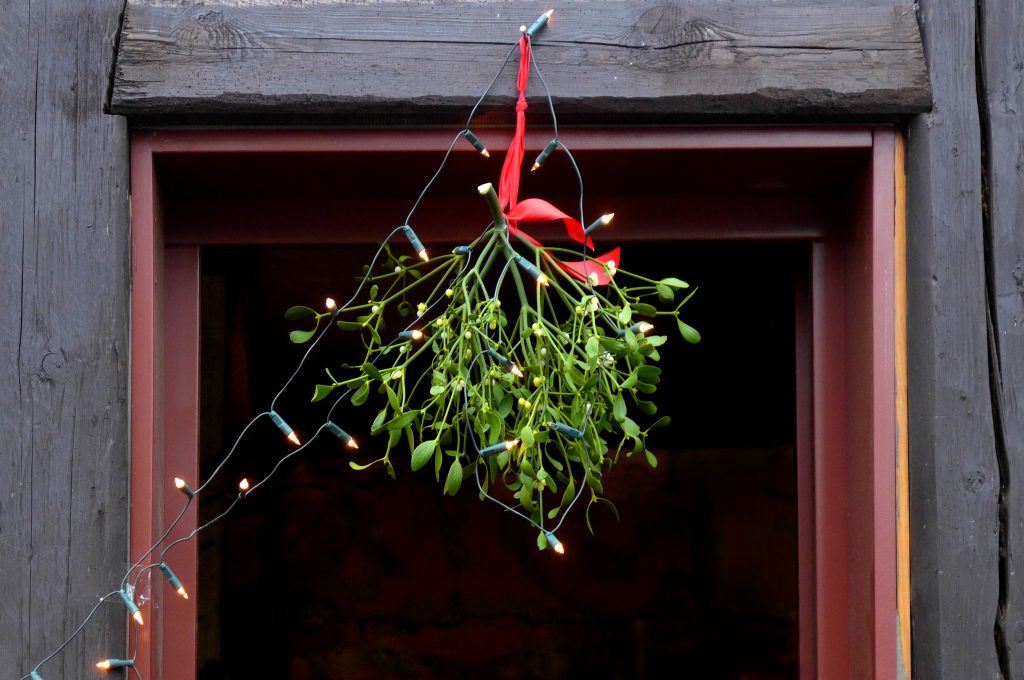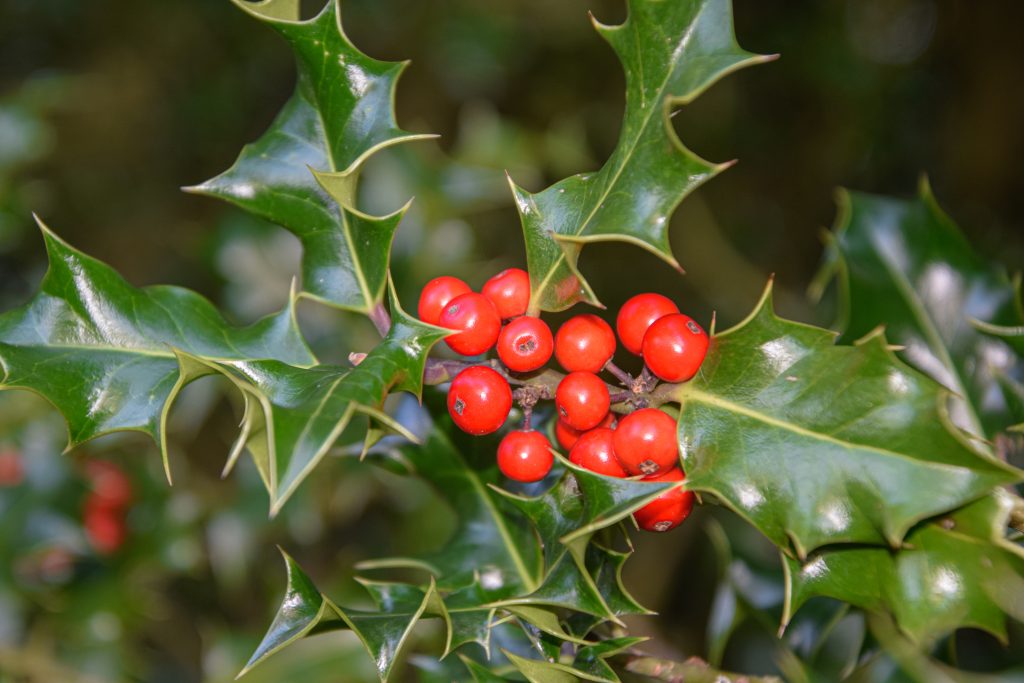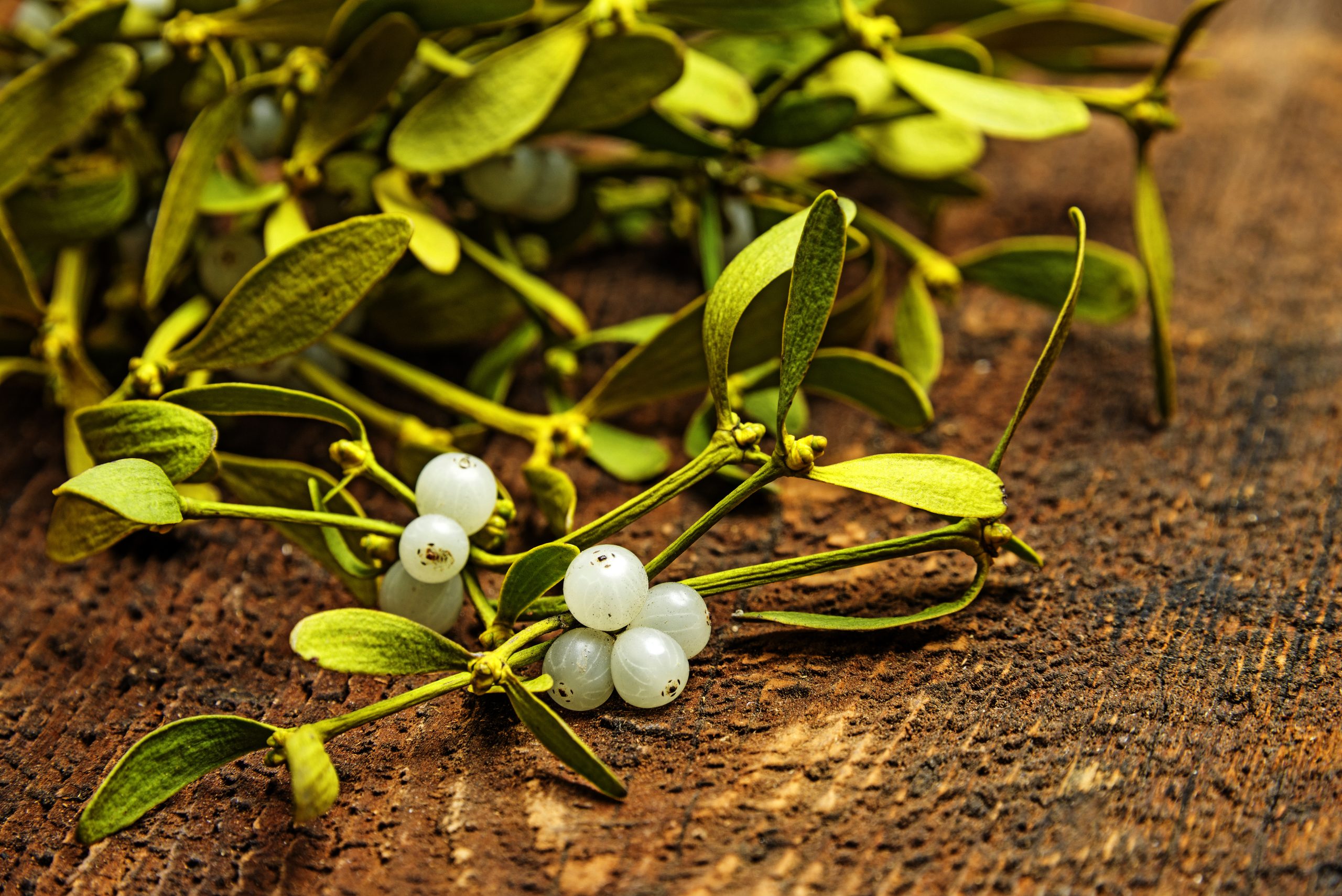Mistletoe is a parasitic plant that is commonly associated with the winter holiday season, often used as a decoration to encourage kissing. However, mistletoe is much more than just a festive plant. With a rich history and a range of medicinal properties, mistletoe has been used for centuries in traditional medicine.
Table of Contents
What is Mistletoe?
Mistletoe is a plant that is a hemiparasite organism that grows on host trees, often deciduous trees like oak, apples, conifers, and poplar. The plants connect with their host tree or shrub using a specialized structure known as the haustorium. This intricate attachment lets them draw out essential water and nutrients from the host plant.
Mistletoe is known for its distinctive green leaves and white berries and is often used as a Christmas decoration during the winter holidays. These parasitic plants can be part of these families: Loranthaceae, Misodendraceae, and Santalaceae.
Mistletoe is also known by several other common names, including “Viscum album,” “European mistletoe,” and “Christmas mistletoe.” The plant is native to Europe but is now found in many other parts of the world, including North America, where it has been introduced.
The fruit of mistletoe is a white or yellowish berry, similar in appearance to white currants, which is toxic to humans and most animals if consumed. However, it is an important food source for birds, which can digest the poisonous fruit and distribute the seeds through their droppings.
As for its flavor, mistletoe is not typically consumed by humans due to its toxicity. However, some species of mistletoe have been used in traditional medicine for their supposed health benefits. For example, mistletoe extracts have been used to treat conditions such as high blood pressure, epilepsy, and even cancer, although the effectiveness of these treatments is still being studied.
There are more mistletoes, such as European mistletoe (Viscum album) and American mistletoe (Phoradendron serotinum). The Arceuthobium minutissimum (the North American dwarf mistletoe) is one of the smallest plants you will see.
The History of Mistletoe
While it may be seen as a mere holiday decoration today, mistletoe’s rich history and evolution as a tradition are worth remembering and cherishing.
The mistletoe was not just a decoration but a sacred and mystical plant revered by different cultures throughout history. Its evolution as a tradition can be traced back to ancient Greece, where mistletoe’s white berries symbolized male fertility. The Greeks believed mistletoe had the power to protect and ensure one’s return from the underworld, as evidenced in the myth of Aeneas.
In ancient Celtic times, Druid priests considered mistletoe a sacred plant with great medicinal and mythical powers. They performed the “ritual of oak and mistletoe” to harvest the plant, believing it could make sterile animals give birth and counteract poison. The ritual involved sacrificing two white bulls and feasting under the oak tree where mistletoe grew.
Norse mythology tells a tale of mistletoe as the arrow that killed the god Baldur, a tragedy that brought about the plant’s association with love and truces.
Romans hung mistletoe over their doorways as a symbol of peace, love, and understanding, while the early Christians used it as a sign of vitality and fertility during Christmas.
The tradition of kissing under the mistletoe started in England in the 1700s among the servant class. It became firmly established in England and the United States during the reign of Queen Victoria in the 1800s. Kissing under the mistletoe has become a symbol of love and a way to make up for feuding spouses, with the notion that those who kiss under it will be wed.

Is Mistletoe Poisonous?
Mistletoe is considered toxic to humans and animals if ingested in large amounts. Mistletoe contains several poisonous substances, including phoratoxin, viscotoxin, and lectins.
When ingested in large amounts, these toxins can cause gastrointestinal symptoms such as nausea, vomiting, diarrhea, and stomach pain. Mistletoe poisoning can cause a slowed heartbeat, lowered blood pressure, and difficulty breathing in severe cases.
Mistletoe toxicity can also affect other animals, such as dogs, cats, and horses, and can cause similar symptoms to those seen in humans. However, some birds, such as the mistle thrush, European robin, blackcap, and certain insects, can eat mistletoe without any adverse effects.
What is Mistletoe Used For?
While not typically used in cooking, mistletoe has several other popular uses:
Decorations: One of the most common uses of mistletoe is decoration during the holiday season. It is often hung above doorways or in other prominent locations where it is easily seen. According to tradition, when someone is standing beneath the mistletoe, it is customary for them to receive a kiss.
Medicinal purposes: Mistletoe has been used for medicinal purposes for centuries. It has been used to treat various conditions, including high blood pressure, epilepsy, and arthritis.
Ornamental plants: Some people grow mistletoe as an ornamental plant. It can be grown on various trees and is often used to add interest to an otherwise plain tree.
Folklore and superstitions: Mistletoe has been associated with various traditions throughout history. In some cultures, it was believed to have magical properties and was used to ward off evil spirits. It was also believed to bring good luck and fertility.
Bird food: Mistletoe berries are a food source for many species of birds, and some people plant mistletoe in their yards to attract birds.
Is There a Difference Between Mistletoe Fruit and Mistletoe Berries?
There is no “Mistletoe fruit” or “Mistletoe berries.” Mistletoe is a plant that produces small, round, white berries.
These berries are the fruit of the mistletoe plant and are typically referred to simply as “mistletoe berries.” So, there is no difference between “mistletoe fruit” and “mistletoe berries” as they are the same.
Why Do People Kiss Under Mistletoe?
The tradition of kissing under the mistletoe has been around for centuries and is rooted in ancient pagan rituals. Mistletoe is a plant that grows on various trees and is considered sacred by the Druids, who believed it had magical powers and could bring good luck and ward off evil spirits.
During the winter solstice, the Druids would gather mistletoe from oak trees and use it in their religious ceremonies. They would hang it over doorways and offer it as a symbol of peace to those who passed under it. It was also believed that anyone who stood beneath the mistletoe was granted protection and immunity from harm.
In the 18th and 19th centuries, kissing under mistletoe became popular in Europe, particularly in England. It was believed that if a man and woman met under the mistletoe, they were obligated to kiss, bringing them good luck and happiness in the coming year. If a woman refused to kiss, it was said that she would be cursed with bad luck.
Over time, the tradition evolved to include kissing under the mistletoe during Christmas. Today, mistletoe is often hung in homes, offices, and public places during the holiday season, and couples are encouraged to kiss under it. It has become a fun and festive tradition that many people worldwide enjoy.

Mistletoe’s Importance to Ecosystems
As mentioned, mistletoes are a group of plants that thrive by stealing water and nutrients from other plants to which they attach themselves. Their unique structure allows them to penetrate their host plant’s tissues and siphon off the resources they need to survive.
But despite their parasitic nature, mistletoes can also provide essential resources such as food, shelter, and hunting grounds for various animals, including birds, butterflies, mammals, and even fish.
Fallen mistletoe leaves release nutrients into the forest floor that would otherwise be trapped within the trees. This generosity creates a ripple effect through the food chain, benefitting many other species in the ecosystem.
So, mistletoes can share their nutrients precisely because of their parasitic nature. Furthermore, mistletoes have a two-way relationship with birds: they provide food for the birds, and in return, the birds help them reproduce and spread.
When birds eat these berries, two things can happen. Some birds swallow the whole fruit. The mistletoe seed, still wrapped in its sticky coating, passes through the bird’s digestive system and is deposited on a tree branch in bird droppings. Others may eat only parts of the fruit, but the result is the same: the sticky seed is left on a tree.
But birds don’t just help with seed dispersal, they also pollinate mistletoe flowers, often full of nectar. When a bird dips its beak into a flower for a sip of nectar, pollen from the flower sticks to the bird. When the bird visits another flower, it carries the pollen with it, helping the mistletoe reproduce.
Other animals, such as mammals and even certain fish, deer, porcupines, rhinoceroses, possums, and caterpillars, can also use mistletoe as food.
The plant is also a hub of activity, providing shelter for many creatures, such as squirrels, birds, and even larger mammals. A staggering 245 bird species have been found nesting in mistletoes in Australia.
Beyond this, when its leaves fall and decay, they act as a natural fertilizer, providing essential nutrients to the soil, plants, insects, and fungi. This enriches the environment and promotes biodiversity.
The importance of mistletoe in the ecosystem was highlighted in an experiment where scientists removed many mistletoe plants from certain areas in Australia. The result was a significant drop in bird populations in those areas, suggesting that mistletoe plants are vital for maintaining healthy wildlife populations.
Where to Purchase Mistletoe?
Mistletoe can usually be found in garden centers and florists during the holiday season, typically from November to January. It’s a popular decoration during Christmas time and is used for hanging over doorways or as part of a centerpiece.
In addition to physical stores, you can buy mistletoe online from various retailers. When searching for mistletoe, choose a reputable seller and check their shipping policies to ensure the product arrives in good condition.
Note: mistletoe is a parasitic plant that grows on trees, so it’s not typically sold as a potted plant. Instead, it’s usually sold in small bundles or as a single sprig.

